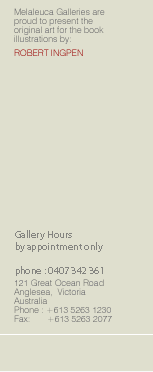 |
 |
 |
 |
 |
 |
| Click thumbnails to view images in full | ||
About the artist:
Some years ago at the Melaleuca Gallery I held an exhibition of paintings depicting The Great Ocean Road on the southern coast of Victoria. My mate Brian Smith from Anglesea flew me over the area in his small plane so I asked him about the logistics of a flight over the Lake Eyre and Painted Desert regions of the interior. He greeted the idea with enthusiasm and we decided throw our swags down for a few days at Oodnadatta. Winter was the time to go as the light was clearer and Oodnadatta would be free of flies and bugs; they make the place impossible during the warmer months. So we headed north to the desert in June 2005.
Although appearing to be in the middle of nowhere, Oodnadatta is critically located in the outback. It sits halfway along the Oodnadatta track and provides services for thousands of tourists each year. I chose it as a base for gathering material for my paintings as it has an airstrip and Avgas and is only a short flight from the Painted Desert, the Simpson Desert and Lake Eyre.
The Intercontinental Hotel at Oodnadatta is managed by Kath and Alan who made us feel at home. We were given the run of the pub on a tab basis and they were kind enough to loan us their truck so that we could get our gear to and from the airstrip early each morning. One morning Kath packed us a hamper of bacon and eggs with all the trimmings and we landed on a deserted strip alongside the old Ghan train line.
Brian filed a few stone chips from the prop while I made breakfast.
There is nothing like the taste of bacon and eggs and toast cooked on the hot coals of an old red gum rail sleeper; the only sounds were a butcher bird's yodel and the sizzle of bacon frying.Flying low over the desert is fun. The land rushes away below and a new landscape flashes for a few seconds, disappears and is replaced by another just as fascinating. This low level madness was motivated by the urge to portray the Australian landscape from above, where one gets a sense of the vastness of the weather-worn plains and a hint of the bones beneath.
I found it strange that the most obvious natural influence on the desert is water. Even a casual observer can see the influence of millions of years of roaring torrents written across the dry surface of the outback in a rhythmic calligraphy of sandy watercourses lined with trees. Trees that become sparser and diminished as the older creeks are by-passed to make way for newer short-cuts forged by the more recent rain; rain infrequent, short in duration but devastating in its rush to leave a new signature on the fragile surface of this ancient land.
For forty years as an artist I have battled the elements in various regions of Australia - the Kimberly, the Red Centre, Bass Strait, the great rolling hills of the Macleay Valley and the Capertee Valley but none so challenging as the nothingness of the desert.
It's hard to paint the sound of a Butcher bird's yodel and even harder to paint silence. The paintings in the exhibition at the Melaleuca Gallery are a sincere attempt to do both of these things; it is for others to judge if I have succeeded.
Robert Wilson
